Ijraset Journal For Research in Applied Science and Engineering Technology
- Home / Ijraset
- On This Page
- Abstract
- Introduction
- Conclusion
- References
- Copyright
Smart Irrigation
Authors: Susheel Sriram Ananthan
DOI Link: https://doi.org/10.22214/ijraset.2022.43802
Certificate: View Certificate
Abstract
Agriculture plays a major role in the GDP of the country specially countries like India. It is observed that 70% of India’s population depends on agriculture for employment. As India is the second largest country in the growth of population so it is necessary to increase the rate of production of agriculture to meet the population food consumption rate. IoT as a technology helps the farmers to fight with most of the agriculture problems. One such problem is irrigation. This paper will discuss about the automation of irrigation on the basis Internet Of Things with microcontrollers, sensors and Human Machine Interface that will minimize the number of workers in a crop field, control and save water and electricity, Increase agricultural production using minimal usage of water, minimize manual intervention in watering operations which also preserves plants from fungi.
Introduction
II. INTRODUCTION
The project we chose is a concept to automate irrigation system. Here we use a smart microcontroller (which serves as the ‘information gateway’), soil moisture sensors and temperature sensors, which are placed on the fields to send real-time data to the microcontroller. The flow of information between the microcontroller and the cloud is supported by stable network services such as Wi-Fi, LoRaWAN. Generally, a ‘moisture range’ is specified, and whenever the real time values from the field sensors are out of this range, the microcontroller actuates desired control action to switch ON/OFF the water pump using relay.
Incorporated Human Machine Interface (HMI) to view the data such as moisture content in soil and other related parameters, to pre-set threshold value of desired parameters to be maintained, also an option of automatic mode and manual mode of irrigation. We believe this project could be implemented on large scale by considering other external factors and could be used extensively useful for farmers to avoid water wastage and improve the quality of crop growth in their fields by:
- determining the soil moisture levels accurately,
- irrigating at the accurate intervals, and
- minimizing runoffs and other wastages.
II. HARDWARE/SERVICES USED
A. Microcontroller:
- ESP8266:
- Microcontroller: Tensilica 32-bit RISC CPU Xtensa LX106
- Operating Voltage: 3.3V
- Input Voltage: 7-12V
- Digital I/O Pins (DIO): 16
- Analog Input Pins (ADC): 1
- UARTs: 1
- SPIs: 1
- I2Cs: 1
- Flash Memory: 4 MB
- SRAM: 64 KB
- Clock Speed: 80 MHz
- USB-TTL based on CP2102 is included onboard, Enabling Plug n Play
- PCB Antenna
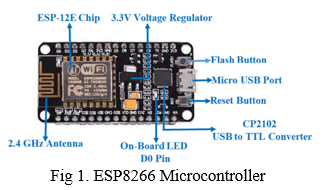
B. Sensor:
1)Soil Moisture Sensor - FC-28:
- Input voltage 3.3-5v
- Output voltage 0-4.2v
- Input Current 35mA
- Output Signal: Both Analog and Digital
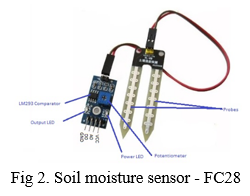
2. Temperature Sensor - DTH-11:
- Operating Voltage: 3.5V to 5.5V
- Operating current: 0.3mA (measuring) 60uA (standby)
- Output: Serial data
- Temperature Range: 0°C to 50°C
- Humidity Range: 20% to 90%
- Resolution: Temperature and Humidity both are 16-bit
- Accuracy: ±1°C and ±1%

C. Services:
Blynk Cloud Platform
D. Electronic Components:
- Water Pump (JT80 SL):
- Length: 56 mm (include water inlet)
- Diameter: 24 mm
- Weight: 30 g
- Height: 33 mm (include water outlet)
- Water inlet:
- Outside diameter
- Inner diameter: 4.5 mm
- Water outlet:
- Outside diameter: 7 mm
- Inner diameter: 4.5 mm
- Voltage range: 2.5-6V DC
- Operating current: 130-220 MA
- Hydraulic head: 40-110 cm
- Flow: 80-120 L/H
- Power: 0.4-1.5W
- Relay Module:
- Digital output controllable
- Compatible with any 5V microcontroller such as Arduino.
- Rated through-current: 10A (NO) 5A (NC)
- Control signal: TTL level
- Max. switching voltage 250VAC/30VDC
- Max. switching current 10A
- Size: 43mm x 17mm x 17mm
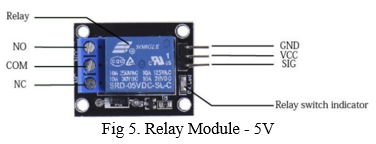
3. Solderless Bread Board
4. Jumper wires
5. MOSFET
6. 10 KOhms Resistor
III. SOFTWARES USED
A. Arduino IDE
Arduino is an open-source prototyping platform based on easy-to-use hardware and software. The Arduino Integrated Development Environment - or Arduino Software (IDE) - contains a text editor for writing code, a message area, a text console, a toolbar with buttons for common functions and a series of menus. It connects to the Arduino and Genuino hardware to upload programs and communicate with them. Programs written using Arduino Software (IDE) are called sketches. Upload Compiles your code and uploads it to the configured board. It can run on any platform like on Windows, Mac OS X, and Linux.
B. Blynk
Blynk was designed for the Internet of Things. It can control hardware remotely, it can display sensor data, it can store data, visualize it, and do many other cool things.
There are three major components in the platform:
- Blynk App: Allows to create amazing interfaces for your projects using various widgets we provide.
- Blynk Server: Responsible for all the communications between the smartphone and hardware. You can use our Blynk Cloud or run your private Blynk server locally. It is an open source, could easily handle thousands of devices and can even be launched on a Raspberry Pi.
- Blynk Libraries: For all the popular hardware platforms - enable communication with the server and process all the incoming and outcoming commands.
Every time a Button pressed in the Blynk app, the message travels to the Blynk Cloud, where it finds its way to the hardware. It works the same in the opposite direction and everything happens in a blink of an eye.
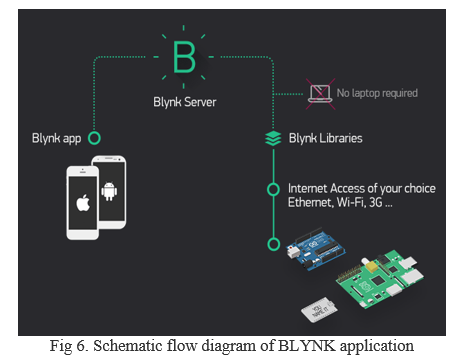
IV. PRINCIPLE OF WORKING
In this Proposed System, both the sensors DHT-11 temperature sensor and FC-28 soil moisture sensor are connected to the input pins of ESP8266 microcontroller board. The measured analog value from soil moisture sensor is converted to a digital output value by ESP8266 microcontroller. The pump gets switched ON/OFF automatically, though relay control action, based on the sensed value with respect to pre-set threshold value (percentage of moisture content), set using BLYNK application. All the information from the sensors is graphically shown inside the BLYNK app which is used for continuous monitoring and controlling. By using this system, the end user will be highly benefited because this system is cost effective, easy to operate. Traditional or manual way of irrigation system will be time consuming and more uses of water, but this system will help user by self-irrigating, which help to save time and save a lot of water.
Apart from automatic mode of operation we have also incorporated manual operation of the controller. Irrigation systems often require maintenance provided by system experts. Manual operation gives these end users to access the system controller remotely using a button input in BLYNK app. The button is programmed to switch ON/OFF the water pump manually if necessary.
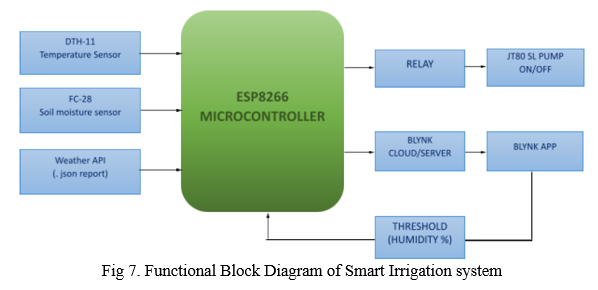
V. SIMULATION
A. Hardware Connection:
- Circuit connections are made on the breadboard as shown in the circuit schematic diagram Fig. 8. Once the connection is made, controller is connected to computer.
- Then the embedded C code is compiled and uploaded to the micro-controller board using Arduino Integrated Development Environment.
- Once the upload is successful, BLYNK application on mobile device is started. Once it starts, it is in standby mode to receive and transmit data, to and from the microcontroller.
- Then connection is established between BLYNK app and Micro-controller using Wi-Fi is initiated which enables data transfer.
- Once the network connection is established, pre-set of minimum threshold is set on the BLYNK application if the operating mode is automatic and the system is ready to work.
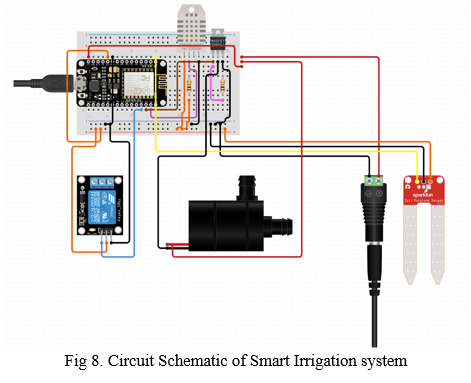
B. Algorithm (Automatic Operation):
- User sets moisture range on BLYNK mobile application based on type of crop grown.
- Soil moisture sensor senses the moisture content of the soil (less than or more than) and the temperature measurement is taken. Reference of moisture requirements is as shown in Table 1.
- If the moisture sensed value is greater than the fixed threshold value than no need to switch on the water motor.
- If the Moisture level is less than the lower threshold value, then the water motor is switch-on automatically.
- Once moisture level comes equal to the upper threshold value, the water pump is switch OFF.
- Process reapeates in cycles
TABLE I
Temperature and moisture requirements of major crops
|
Sr. No |
Crop Name |
Temperature |
Moisture Range |
|
1 |
Rice |
21-37 |
20-25 |
|
2 |
Wheat |
10-15 |
14-20 |
|
3 |
Barley |
20-38 |
20-25 |
C. Program Code:
#include <SoftwareSerial.h>
#include <BlynkSimpleStream.h>
#define BLYNK_PRINT SwSerial
#define trigger 19
#define moisture 18
#define pump 4
#define temperature 17
//Authentication code to access out smart irrigation BLYNK server
char auth[] = "wcWfEnmNKjyxpNrRI9NiOvFfUFS8_ZLF";
float val = 0;
bool flag = 0;
int value = 0;
int value_max = 0;
SoftwareSerial SwSerial(2, 3);
BLYNK_WRITE(V5) {
int pinValue = param.asInt(); //To display moisture sensor value in BLYNK app
}
BLYNK_WRITE(V7) {
int pinValue = param.asInt(); //To display temperature sensor value in BLYNK app
}
BLYNK_WRITE(V6) {
int pinValue = param.asInt(), //Threshold value(max) set in BLYNK app
value_max = pinValue
}
BLYNK_WRITE(V0) {
float pinValue = param.asFloat(); //Threshold value(min) set in BLYNK app
val = pinValue;
}
BLYNK_WRITE(V1) {
int pinValue = param.asInt(); //Manual control ON/OFF signal
value = pinValue;
}
void setup()
{
SwSerial.begin(9600);
Serial.begin(9600);
Blynk.begin(Serial, auth);
pinMode(trigger, OUTPUT);
pinMode(moisure, INPUT);
pinMode(temperature, INPUT);
pinMode(pump, OUTPUT); //For water motor/ pump
}
void loop()
{
//Expression to display humidity in % based on the analog value from soil moisture sensor:
sensor_value = analogRead(moisture);
Blynk.virtualWrite(V5, sensor_value);
//Expression to display humidity in % based on the analog value from soil moisture sensor:
value = analogRead(temperature);
Blynk.virtualWrite(V7, value);
//Control action of turning ON pump using relay control action if sensed data is below threshold value:
if (sensor_value < val) {
Blynk.notify("Caution limit exceeded!!");
}
if (sensor_value < val || flag == 1 || value == 1) {
flag = 1;
myservo.write(0);
digitalWrite(pump, HIGH);
delayMicroseconds(1000);
digitalWrite(pump, LOW);
myservo.write(180);
delayMicroseconds(1000);
myservo.write(0);
digitalWrite(pump, HIGH);
delayMicroseconds(1000);
}
//Control action of turning OFF pump using relay control action if sensed data is above threshold value
if (flag == 1 && sensor_value > 20 && value==0) {
digitalWrite(pump, LOW);
flag = 0;
}
Blynk.run();
delay(500);
}
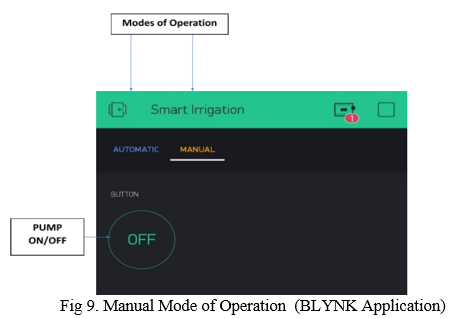
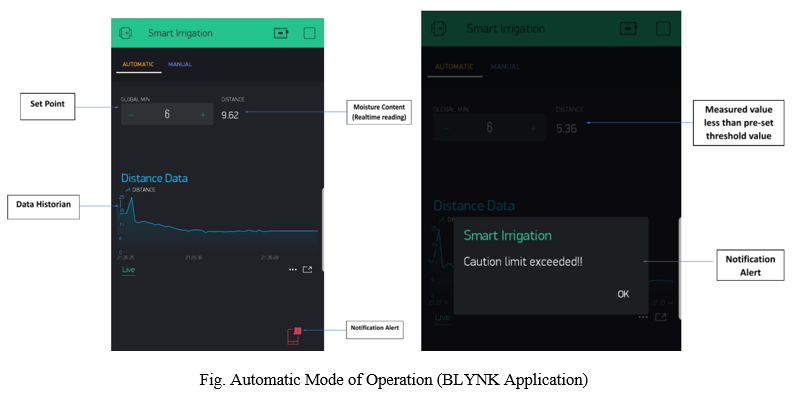
VI. FUTURE SCOPE
A. Time bound administration of fertilizer, insecticides and pesticides can be introduced.
B. A water meter can be installed to estimate the amount of water used for irrigation and thus giving a cost estimation and a solenoid valve can be used for varying then volume of water flow.
C. This device can be made to perform better by providing the power supply with the help of renewable sources.
D. User Interface can be made to display the estimated billing of water utilized for irrigation and amount of water present in reservoir.
Conclusion
As many initiatives have already taken by the Indian government to promote Agriculture. Every year irrigation requires more water consumption than rainfall, which will lead to a critical problem of water resources for the future generation. It is also difficult for farmers to find ways which need less water to grow crops. From many surveys, the report is that agriculture uses 85% of the fresh water. If this percentage of freshwater usage continues to grow, then it becomes a serious problem with respect to an increase in population growth and increases in demand for food. To preserve water resources for future generation and for proper usage of water resources, it is necessary to adopt some strategies so that minimal water is used as per requirement. Hence. usage of Internet of Things which enables us to adopt the strategies to monitor and limit the usage of water resources in agriculture fields through automation with interfacing with android applications must be implemented which can significantly reduce the wastage of water resources.
References
[1] Design and Implementation of Automatic Plant Watering System by “Archana and Priya” presented at International Journal of Advanced Engineering and Global technology, vol-04, Issue-01, Jan-2016. [2] Sensor Based Automated Irrigation System with IOT by “Karan Kansara and Vishal Zaweri,” presented at International Journal of Computer Science and Information Technologies, vol-06, 2015. [3] C. Arun, K. Lakshmi Sudha “Agricultural Management using Wireless Sensor Networks – A Survey”2nd International Conference on Environment Science and Biotechnology IPCBEE vol.48 (2012) © (2012) IACSIT Press, Singapore 2012. [4] Venkata Naga Rohit Gunturi, “Micro Controller Based Automatic Plant Irrigation System” International [5] Journal of Advancements in Research and Technology, Volume 2, Issue-4, April-2013. [6] www.arduino.cc [6] Automated Plant Watering System using the Internet of Things Technology in India by S. “Archana, G. Nishanth, E. S. Praveen Kumar, G. Nandha Kumar”, in “Recent Trends in Microelectronics and Nanoelectronics Volume 2 Issue 3 in Mantech Publications-2017”
Copyright
Copyright © 2022 Susheel Sriram Ananthan. This is an open access article distributed under the Creative Commons Attribution License, which permits unrestricted use, distribution, and reproduction in any medium, provided the original work is properly cited.

Download Paper
Paper Id : IJRASET43802
Publish Date : 2022-06-04
ISSN : 2321-9653
Publisher Name : IJRASET
DOI Link : Click Here
 Submit Paper Online
Submit Paper Online

